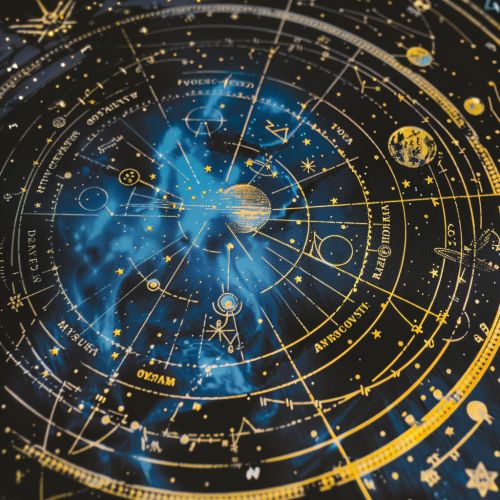Natal Astrology
Introduction
Natal astrology, also known as genethliacal astrology, is a branch of astrology that focuses on the creation and interpretation of a natal chart, which is a map of the positions of celestial bodies at the exact moment of an individual's birth. This form of astrology is used to provide insights into an individual's personality, life path, and potential future events based on the alignment of the planets and other celestial phenomena. Unlike other forms of astrology, natal astrology is highly personalized, relying on the precise time, date, and location of birth to generate an accurate chart.
Historical Background
The origins of natal astrology can be traced back to ancient civilizations, including the Babylonians, Egyptians, and Greeks. The Babylonians are credited with developing the earliest forms of astrology around the 2nd millennium BCE. They created the first astrological charts and began to interpret the movements of celestial bodies as omens.
The Greeks further refined these techniques, with notable contributions from philosophers and mathematicians such as Ptolemy and Hipparchus. Ptolemy's work, the "Tetrabiblos," became a foundational text for Western astrology, outlining the principles of natal astrology and the significance of planetary positions.
Components of a Natal Chart
A natal chart, also known as a birth chart or horoscope, consists of several key components:
The Zodiac
The zodiac is a belt of the sky divided into twelve equal parts, each named after a constellation. These twelve signs are Aries, Taurus, Gemini, Cancer, Leo, Virgo, Libra, Scorpio, Sagittarius, Capricorn, Aquarius, and Pisces. Each sign has specific characteristics and influences on the planets that occupy them.
Planets
In natal astrology, the term "planet" includes the Sun and the Moon, in addition to the traditional planets: Mercury, Venus, Mars, Jupiter, Saturn, Uranus, Neptune, and Pluto. Each planet represents different aspects of life and personality traits. For example, Venus is associated with love and beauty, while Mars is linked to aggression and action.
Houses
The natal chart is divided into twelve sections called houses, each representing different areas of life, such as career, relationships, and home. The position of planets within these houses provides insights into how various life aspects will manifest for the individual.
Aspects
Aspects are the angles formed between planets on the natal chart. Major aspects include the conjunction, opposition, trine, square, and sextile. These angles indicate how planets interact with each other and influence the individual's life. For instance, a trine is considered harmonious, while a square may indicate challenges.


Interpretation of a Natal Chart
Interpreting a natal chart involves analyzing the positions and relationships of the zodiac signs, planets, houses, and aspects. This complex process requires a deep understanding of astrological principles and symbolism.
Sun Sign
The Sun sign, determined by the position of the Sun at the time of birth, is one of the most well-known aspects of a natal chart. It represents the core essence and identity of the individual. For example, a person with the Sun in Leo may be confident and charismatic.
Moon Sign
The Moon sign, based on the Moon's position, reflects the individual's emotional nature and subconscious mind. A person with the Moon in Cancer may be nurturing and sensitive.
Rising Sign (Ascendant)
The rising sign, or ascendant, is the zodiac sign that was rising on the eastern horizon at the time of birth. It represents the individual's outward behavior and first impressions. For instance, an individual with Aries rising may appear assertive and energetic.
Planetary Positions
Each planet's position in a specific sign and house provides detailed insights into various life aspects. For example, Venus in the 7th house may indicate a strong focus on relationships and partnerships.
Advanced Techniques
Beyond the basic components, advanced techniques in natal astrology offer deeper insights and more precise predictions.
Progressions
Progressions involve advancing the natal chart to reflect the individual's growth and development over time. The most common method is the secondary progression, where each day after birth represents one year of life.
Transits
Transits refer to the current positions of planets and their interactions with the natal chart. Astrologers use transits to predict future events and trends. For example, a transit of Saturn over the natal Sun may indicate a period of significant responsibility and challenge.
Solar Returns
A solar return chart is created for the moment the Sun returns to its exact natal position each year. This chart provides insights into the themes and events for the upcoming year.
Criticism and Controversy
Natal astrology, like other forms of astrology, has faced criticism and skepticism from the scientific community. Critics argue that there is no empirical evidence to support astrological claims and that the practice relies on confirmation bias and Barnum effect. Despite this, natal astrology remains popular and influential in many cultures.
Conclusion
Natal astrology offers a unique and personalized approach to understanding an individual's personality, life path, and potential future events. By analyzing the positions and relationships of celestial bodies at the time of birth, astrologers provide insights that can guide personal growth and decision-making.
